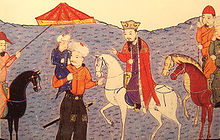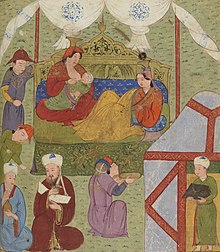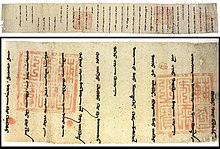Arghun

Arghun ( Mongolian ᠠᠷᠭᠦᠨ Arġun ; approx. 1258 ; † March 7, 1291 ) was the fourth ruler of the Mongolian Ilkhan from 1284 to 1291 . He was the son of Abaqa and like this Buddhist (although also pro-Christian). He was known for sending several embassies to Europe with the intention of forging a Franco-Mongolian alliance against the Muslims in the Holy Land . It was also Arghun who asked his great-uncle Kublai Khan for a new bride. The task of taking the young princess cook through Asia to Arghun was (allegedly) taken over by Marco Polo . Arghun died before Kökötchin arrived, so she instead married Arghun's son Ghazan , who converted to Islam .
biography

Arghun was born the son of Abaqa Khan and the Christian Mongolian princess Haimasch Chatun. Arghun himself had several wives, his favorite being Buluqhan Khatun. She raised Arghun's two sons named Ghazan Ilchan and Öldscheitü , both of whom later succeeded their father to the throne and converted to Islam . Arghun had Öldscheitü baptized Christian and gave him the name Nicholas after Pope Nicholas IV. According to the Dominican missionary Riccoldo da Monte di Croce, he was a man given to the worst of villainy, but for all that a friend of the Christians . One of Arghun's sisters named Oljalh married the Georgian prince Vakhtang III.
Arghun was a Buddhist, but like most Mongols he showed great tolerance towards other religions and so the Muslims were also able to apply the Sharia for themselves. His finance minister, Sa'ad ad dawla, was Jewish . Sa'ad was successful in restoring order to the administration of the Ilchanate, in part by aggressively denouncing the abuse of Mongol military leaders.
Conflicts
Arghun's rule was relatively peaceful and there was little conflict with his Mongol comrades. In 1288 and 1290, he fought back twice invading the Golden Horde under Tulabugha in the Caucasus .
During the rule of Arghun, the Mamluks of Egypt continuously increased their power in Syria, and the Mamluk Sultan Qalawun recaptured Crusader territories, some of which, such as Tripoli County , were vassals of the Mongols. The Mamluks conquered the northern fortress of Margat in 1285 , Latakia in 1287 and completed the conquest of Tripoli in 1289.
More serious were his internal problems. In 1284, under pressure from the Emir Boga (to whom he owed the coup d'état of 1284 and thus his life and throne ), he executed the capable vizier Shams ad-Din Dschuwaini (the historian's brother ), thus initiating the internal decline of the next decade. In 1289 he also executed the Emir Boga, who had become a serious problem due to his power and a planned coup d'état. That's why he had (or his son Ghazan , the youthful governor) in 1289 and 1290 an uprising of Oiratenfürsten Nawruz (or Nauruz) in Khorasan fight, then after Transoxania fled and the local rulers Qaidu or Tchaghatai a brief invasion moved (1291/2). Nawrūz only submitted to Prince Ghazan again around 1294.
During Arghun's reign, the Great Khan Kubilai established Prince Bolad (d. 1313) in Tabriz, who represented Kubilai's interests as ambassador and acted as a kind of viceroy (chinsan) until Ghazan's accession to power in 1295.
Relationship with Christian Powers
Arghun was one of a long line of Mongol rulers who endeavored to forge a Franco-Mongolian alliance with the Europeans against their common enemy, the Egyptian Mamluks. Arghun even promised that if Jerusalem was to be conquered he would be baptized. But by the late thirteenth century Europe was no longer interested in the weakening Crusades, and Arghun's venture ultimately remained fruitless.
First embassy to the Pope
In 1285 Arghun sent an embassy and a letter to Pope Honorius IV , the Latin copy of which has been preserved in the Vatican. Arghun's letter mentions his family's links with Christianity and proposed military action against the Muslim countries:
“The land of the Muslims, Syria and Egypt, lies between you and us, we will circle around them and strangle them. We will send our messengers to ask you to send an army to Egypt so that we on the one hand and you on the other can take it together with good fighters. Let us know when you will do it through sure messengers. We will drive out the Saracens with the help of the King, the Pope and the Great Khan. "
Second embassy to King Philip and King Edward

Apparently without an answer, Arghun sent another embassy to the European rulers in 1287. It was led by the Chinese monk Rabban Bar Sauma and was supposed to form a military alliance to fight the Muslims and to conquer Jerusalem. The answers were positive but vague. Rabban Bar Sauma returned with letters from Pope Nicholas IV, Edward I of England and Philip IV of France in 1288.
Third legation

In 1289 Arghun sent a third embassy to Europe in the person of the Genoese Buscarello de Ghizolfi, who had settled in Persia. The theme of the legation was to determine when the Christians and Mongols would begin their actions. Arghun would march his troops as quickly as possible when the crusaders landed at Acre . Buscarello de Ghizolfi was in Rome between July 15 and September 30, 1289 and in Paris in November / December. He had with him a letter from Arghun to Philip IV, in which Jerusalem was offered as a possible reward for the Christians, and which asked for a fixed date for an offensive in winter 1290 or spring 1291:
“By the power of the eternal heaven! Under the emperor's auspices! [The following are] Ours, Arguns, words = O roi de France (to the Frankish king?)! Your suggestion, which you had brought to us last year through the embassy with Mar Bar Savma sahura at the head: 'If the armies of Il Khan go into the field against Egypt, we too will go into the field from here and in joint operation ( We have agreed to attack in the rear of the enemy and (accordingly) decided to mount our report to the sky in the last winter month of the tiger year (1290) and to serve on the 15th of the first spring month (1291) in front of Damascus. Now We announce to you that, in accordance with Our honest word, We will send Our armies to the appointment (time and place) and, when We take possession of those peoples with the authority of Heaven, we will give you Jerusalem. If you (but) miss the date and thus lead our armies into a wrong action, would that be acceptable? If you regretted it later too, what use would it be? (You would have to regret it later). Furthermore, if you send an envoy of yours with some kind of message and in his care you give rare objects from Franconia, falcons and precious stones of different colors, then the power of heaven and the majesty of the emperor be a witness that We are you in one way or another be rewarded. To say this, we send the quiver-bearer Müskeril. We wrote our letter on the 6th of the last decade of the first summer month in the cattle year (1289) during our stay in Köndelen. "
Buscarello also had a notice with him saying that the Mongol ruler would prepare all necessary support, including 30,000 horses, for the crusaders. Buscarello then went to England to deliver Arghun's message to King Edward I. He reached London on January 5, 1290. Eduard, whose letter of reply has been preserved, replied enthusiastically to the project, but remained evasive when it came to the execution, which he left to the Pope.
In 1290, Arghun began a shipbuilding program in Baghdad with the intention of building war galleys that would affect the Mamluk trade in the Red Sea . Genoa sent 800 carpenters and seamen to help. A group of arbaletriers were also sent, but the operation apparently failed when the Genoese government rejected the project and an internal dispute broke out in the port of Basra between the Genoese families of the Ghibellines and Guelphs .
Fourth legation
Arghun sent a fourth embassy to the European courts in 1290. It was led by Andrew Zagan (or Chagan) who was accompanied by Buscarello de Ghizolfi and a Christian named Sahadin.
In 1291 Pope Nicholas IV declared a new crusade and negotiated with Arghun, Hethum II of Lesser Armenia , the Jacobites , the Ethiopians and the Georgians . On January 5th, Nicholas IV preached a lively sermon to all Christians urging them to save the holy land, and preachers began to gather Christians to follow King Edward I on the crusade. Nevertheless, the effort was too little and it came too late. On May 28, 1291 Acre was captured by the Mamluks after a siege .
In August 1291, Nicholas IV wrote a letter to Arghun informing him of Edward I's plans for a crusade to recapture the Holy Land, saying that the crusade would only be successful with the strong arm of the Mongols.
Nicholas IV repeated an often used topic of communication between the Crusaders and the Mongols and asked Arghun to be baptized and march against the Mamluks. But Arghun died on March 7, 1291 and Pope Nicholas IV in March 1292, so that their attempts to act together were put to an end. Edward I sent the ambassador Geoffrey de Langley to meet Arghun's successor, Gaichatu , in 1292 , but intensive contacts would only arise again under Arghun's son Ghazan Ilchan .
controversy
Historian Steven Runciman wrote: “Had an alliance with the Mongols been reached and sincerely implemented by the West, the existence of the Crusader states could almost certainly have been extended. The Mamluks would have been badly damaged, perhaps even destroyed; and the Ilchanate of Persia would have survived as a power friendly to Christians and the West. ”Contrary to Runciman's optimistic assessment, however, the Islamic influence in the Ilchanate was very strong and a stable Christian-Mongolian alliance was by no means certain. Arghun's predecessor Tekuder had already converted to Islam and Arghun's successors Gaichatu and Baidu had to make concessions to the majority Muslim imperial population and administration before the Ilkhan under Ghazan and Öldscheitü finally became Muslim.
death
Arghun died on March 7, 1291 and was followed by his brother Gaichatu .
In the 13th century, the Mongols became so popular in the west that many newborns in Italy were named after Mongol rulers: names such as Can Grande ( Great Khan ), Alaone ( Hülegü ), Argone (Arghun) or Cassano (Ghazan) were common.
Marco Polo
Arghun was the reason that Marco Polo was able to return to Venice after 23 years in China . Arghun lost his favorite wife, Buluqhan Khatun. He had three envoys ask his great-uncle and ally Kublai Khan to send him a relative of Buluqhan Khatun as a new bride. The choice fell on the 17-year-old cook (Blue or Heavenly Lady). Marco Polo was entrusted (according to his book, but not the Chinese sources) with the task of escorting the princess to Persia by sea. The world traveler embarked in 1291 together with his father Niccolò , his uncle Maffeo Polo, the Persian ambassador, the princess and about 600 other people on 14 junks . The fleet drove through the Indian Ocean to Persia. The trip lasted two years. Arghun had died long before the arrival of the Polos and the princess. Instead, Kökötchin married his son Ghazan Ilchan.
See also
swell
- William of Tire : Historia rerum in partibus transmarinis gestarum French original online
literature
- EA Wallis Budge : The Monks of Kublai Khan Emperor of China online version
- Laurent Dailliez: Les Templiers , 1972 Editions Perrin, ISBN 2-262-02006-X
- Richard Foltz : Religions of the Silk Road , New York: Palgrave Macmillan, 2010, ISBN 978-0-230-62125-1
- René Grousset : Histoire des Croisades III, 1188-1291 , 1935 Editions Perrin, ISBN 2-262-02569-X
- René Grousset, Naomi Walford: The Empire of the Steppes: a History of Central Asia , 1970 NJ: Rutgers University Press
- Peter Jackson: The Mongols and the West: 1221-1410 , Longman, ISBN 978-0-582-36896-5
- Claude Lebédel: Les Croisades, origines et conséquences , 2006 Editions Ouest-France, ISBN 2-7373-4136-1
- Amin Maalouf : The Crusades through Arab Eyes , 1984 New York: Schocken Books, ISBN 0-8052-0898-4
- Michael Prawdin : Mongol Empire , 1940/1961 Collier-Macmillan Canada, ISBN 1-4128-0519-8
- Jean Richard: Histoire des Croisades , 1996 Fayard, ISBN 2-213-59787-1
- Morris Rossabi: Voyager from Xanadu: Rabban Sauma and the first journey from China to the West , 1992 Kodansha International Ltd., ISBN 4-7700-1650-6
- Steven Runciman : A history of the Crusades 3 , 1987 (1952-1954) Penguin Books, ISBN 978-0-14-013705-7
- Sylvia Schein: Gesta Dei per Mongolos 1300. The Genesis of a Non-Event , In: The English Historical Review Vol. 94, Issue 373 October 1979, pp. 805–819 Preview of the first page , doi : 10.1093 / ehr / XCIV .CCCLXXIII.805
- Christopher Tyerman: God's War: A New History of the Crusades , Harvard University Press 2006, ISBN 0-674-02387-0
Web links
- Family tree of the Genghis Khan dynasty ( Memento from April 15, 2012 in the Internet Archive )
- The Il-Kanate ( Memento from October 15, 2013 in the Internet Archive )
Individual evidence
- ↑ a b "He died on March 7, 1291." Steppes , p. 376
- ↑ "Arghun had one of his sons baptized, Khordabandah, the future Oljaitu, and in the Pope's honor, went as far as giving him the name Nicholas", Histoire de l'Empire Mongol , Jean-Paul Roux, p. 408.
- ↑ Jackson, p. 176
- ↑ Grousset, p. 846
- ↑ Robert Mantran (Robert Fossier, ed.): A Turkish or Mongolian Islam in The Cambridge Illustrated History of the Middle Ages: from 1250 to 1520 , p 298
- ^ Tyerman, p. 817
- ↑ Michael Prawdin, p. 372: "Argun revived the idea of an alliance with the West, and envoys from the Ilkhans once more visited European courts. He promised the Christians the Holy Land, and declared that as soon as they had conquered Jerusalem he would have himself baptized there. The Pope sent the envoys on to Philip the Fair of France and to Edward I of England. But the mission was fruitless. Western Europe was no longer interested in crusading adventures.
- ^ A b Steven Runciman, p. 398
- ↑ "This Arghun loved the Christians very much and asked the Pope and the King of France several times how they could jointly destroy all the Saracens." - Wilhelm von Tire - French original: "Cestu Argon ama mout les crestiens et plusors fois manda au pape et au roy de France trayter coment yaus et luy puissent de tout les Sarazins destruire" Wilhelm von Tire Historia rerum in partibus transmarinis gestarum # 591
- ↑ Amin Maalouf p. 254: Arghun, grandon of Hulagu, "had resurrected the most cherished dream of his predecessors: to form an alliance with the Occidentals and thus to trap the Mamluk sultanate in a pincer movement. Regular contacts were established between Tabriz and Rome with a view to organizing a joint expedition, or at least a concerted one. "
- ↑ Rene Grousset Histoires des Croisades III , p. 700
- ↑ Morris Rossabi, p 99
- ↑ Boyle, in Camb. Hist. Iran V, pp. 370-71; EA Wallis Budge, pp. 165-97.
- ↑ Grands Documents de l'Histoire de France , Archives Nationales de France, p. 38, 2007.
- ↑ Steven Runciman, p. 401
- ↑ German translation from On the letters of the Mongolian Il-Khans Arġun and Öljeitü to King Philip the Beautiful of France (1289 and 1305) by Erich Haenisch, published in Oriens , Vol. 2, No. 2 (Dec. 31, 1949), pp. 216-235
- ^ English translation of the letter ( Memento of June 18, 2008 in the Internet Archive )
- ↑ An alternative English translation
- ↑ a b Jean Richard, p. 468
- ^ Rene Grousset "Histoire des Croisades III", p. 713.
- ^ "Only a contingent of 800 Genoese arrived, whom he (Arghun) employed in 1290 in building ships at Baghdad, with a view to harassing Egyptian commerce at the southern approaches to the Red Sea", p. 169, Peter Jackson, The Mongols and the West
- ↑ a b "Had the Mongol alliance been achieved and honestly implemented by the West, the existence of Outremer would almost certainly have been prolonged. The Mameluks would have been crippled if not destroyed; and the Ilkhanate of Persia would have survived as a power friendly to the Christians and the West. " Steven Runciman, p. 402.
- ↑ Laurent Dailliez, pp. 324-325
- ↑ Sylvia Schein, p. 809
- ↑ Peter Jackson, p. 169
- ↑ Steven Runciman, p. 412
- ↑ Peter Jackson, p. 315
| predecessor | Office | successor |
|---|---|---|
| Tekuder |
Ilkhan of Persia 1284–1291 |
Gaichatu |
| personal data | |
|---|---|
| SURNAME | Arghun |
| ALTERNATIVE NAMES | Arghun Khan (full name); Аргун (Mongolian) |
| BRIEF DESCRIPTION | Mongolian Ilkhan |
| DATE OF BIRTH | around 1258 |
| DATE OF DEATH | March 7, 1291 |